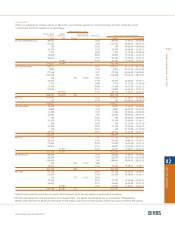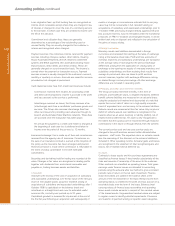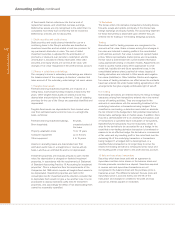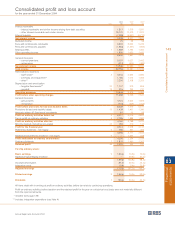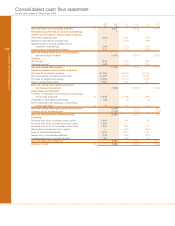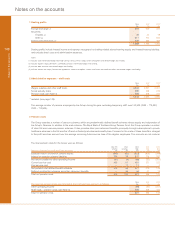RBS 2004 Annual Report Download - page 141
Download and view the complete annual report
Please find page 141 of the 2004 RBS annual report below. You can navigate through the pages in the report by either clicking on the pages listed below, or by using the keyword search tool below to find specific information within the annual report.
section
03
139
Annual Report and Accounts 2004
Accounting policies
Financial
statements
The accounts have been prepared in accordance with applicable
Accounting Standards in the UK and the Statements of
Recommended Accounting Practice issued by the British
Bankers’ Association and by the Finance and Leasing
Association. The Statement of Recommended Practice issued
by the Association of British Insurers (2003) has been followed
by the insurance members of the Group; they have been
consolidated in the recognised manner for banking groups, in
particular, by using the embedded value method for life business.
A summary of the more important accounting policies is set
out below. The consolidated accounts are prepared in
accordance with the special provisions of Part VII of the
Companies Act 1985 (“the Act”) relating to banking groups.
The accounts of the company are prepared in accordance
with section 226 of, and Schedule 4 to, the Act and, as
permitted by section 230(3) of the Act, no profit and loss
account is presented.
Change of accounting policy
FRS 17 ‘Retirement Benefits’ (“FRS 17”) supersedes Statement
of Standard Accounting Practice 24 'Pension costs’ (“SSAP24”)
and the Urgent Issues Task Force Abstract 6 ‘Accounting for
post-retirement benefits other than pensions’. All the disclosure
requirements of FRS 17 were adopted by the Group in its 2002
financial statements. In November 2002, the Accounting
Standards Board deferred the effective date of the recognition
and measurement elements of the standard to accounting
periods beginning on or after 1 January 2005. The Group has,
however, implemented the recognition and measurement
provisions of FRS 17 in 2004 in the light of the introduction of
International Financial Reporting Standards from 1 January
2005; the measurement principles in the equivalent
international accounting standard (IAS 19 ‘Employee Benefits’)
are similar to those in FRS 17.
FRS 17 requires assets in a defined benefit scheme to be
measured at their fair value at the balance sheet date. Scheme
liabilities are measured using the projected unit method, which
takes account of projected earnings increases, using actuarial
assumptions that are mutually compatible and lead to the best
estimate of the future cash flows. These cash flows are
discounted at the interest rate applicable to high-quality
corporate bonds of the same currency and term as the liabilities.
The surplus/deficit in a defined benefit scheme is the
excess/shortfall of the value of the assets in the scheme
over/below the value of the scheme liabilities. A surplus is
recognised as an asset to the extent that the employer is able
to recover the surplus either through reduced contributions in
the future or through refunds from the scheme. A deficit is
recognised as a liability to the extent of the employer’s legal or
constructive obligation to fund it. The current service cost (the
increase in scheme liabilities arising from employee service in the
current period), past service costs (the cost of improvements to
benefits for service relating to prior periods) and interest cost (the
unwind of the discount on scheme liabilities) net of the expected
return on scheme assets are charged to the profit and loss
account. Actuarial gains and losses (changes in surpluses or
deficits due to experience gains and losses and to changes in
actuarial assumptions) are recognised in full in the statement
of total recognised gains and losses for the period.
Under SSAP24 for the main defined benefit scheme the profit
and loss account charge comprised the cost of accruing
benefits for active employees and the amortisation of the
surplus recognised on the acquisition of NatWest offset by a
credit for the amortisation of the scheme surplus. A pension
prepayment was included in the Group’s balance sheet.
The effect of this change of policy on the profit and loss
account has been to credit £85 million (2003 – £52 million; 2002
– £201 million) to Other operating income and to increase
Administrative expenses – staff costs by £217 million (2003 –
£135 million; 2002 – £112 million). Profit before tax has been
reduced by £132 million (2003 – £83 million; 2002 – increased
by £89 million). A deficit, net of deferred tax, of £1,901 million
(2003 – £1,445 million) has been recognised on the balance
sheet; Prepayments and accrued income of £1,079 million
(2003 – £112 million), Other assets of £654 million (2003 – £735
million) and Accruals and deferred income of £26 million (2003
– £18 million) have been eliminated; the liability for deferred
taxation has reduced by £315 million (2003 – £230 million) and
the Deferred tax asset (within Other assets) has increased by
£19 million (2003 – £20 million). Other provisions have
decreased by £73 million (2003 – £43 million) and shareholders’
funds by £3,220 million. A prior year adjustment of £2,001
million is shown in the Statement of consolidated total
recognised gains and losses. The prior year adjustment
comprises: the recognition of the pension deficit at 31
December 2003 of £1,414 million (£1,968 million less deferred
tax of £554 million); the elimination of pension prepayments
less accruals of £58 million (net of deferred tax); and the
elimination of the pension surplus recognised on the
acquisition of NatWest amounting to £529 million (net of
deferred tax and amortisation).
1 Accounting convention and bases of consolidation
The accounts are prepared under the historical cost
convention modified by the periodic revaluation of premises
and certain investments. To avoid undue delay in the
presentation of the Group’s accounts, the accounts of certain
subsidiary undertakings have been made up to 30 November.
There have been no changes in respect of these subsidiary
undertakings, in the period from their balance sheet dates to
31 December, that materially affect the view given by the
Group’s accounts.
2 Revenue recognition
Interest is credited to the profit and loss account as it accrues
unless there is significant doubt that it can be collected (as
described in the accounting policy on loans and advances).
Fees in respect of services are recognised as the right to
consideration accrues through performance to customers.
Services are in respect of financial services related products,
the arrangement is generally contractual, the cost of providing
this service is incurred as the service is rendered and the
price is usually fixed and always determinable. The application
of the Group’s policy to significant fee types is outlined below.
Accounting policies




